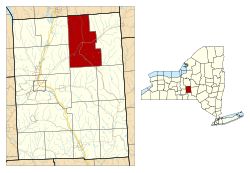Truxton, New York | |
|---|---|
 Main St. (Rt. 13) | |
 Location within Cortland County and New York | |
| Coordinates: 42°42′33″N76°1′25″W / 42.70917°N 76.02361°W | |
| Country | United States |
| State | New York |
| County | Cortland |
| Government | |
| • Type | Town Council |
| • Town Supervisor | Lloyd Sutton |
| • Town Council | Members' List |
| Area | |
• Total | 44.73 sq mi (115.84 km2) |
| • Land | 44.65 sq mi (115.64 km2) |
| • Water | 0.08 sq mi (0.20 km2) |
| Elevation | 1,142 ft (348 m) |
| Population (2010) | |
• Total | 1,133 |
| 1,093 | |
| • Density | 24.48/sq mi (9.45/km2) |
| Time zone | UTC-5 (Eastern (EST)) |
| • Summer (DST) | UTC-4 (EDT) |
| ZIP Codes |
|
| Area code | 607 |
| FIPS code | 36-023-75550 |
| GNIS feature ID | 0979560 |
| Website | www |
Truxton is a town in Cortland County, New York, United States. The population was 1,133 at the 2010 census. [3] The town is named for Commodore Thomas Truxtun, a privateer in the American Revolution and one of the US Navy's first commanding officers.
Contents
- History
- Notable people
- Geography
- Demographics
- Communities and locations in Truxton
- References
- External links
Truxton is in the northeastern part of the county, northeast of the city of Cortland.



